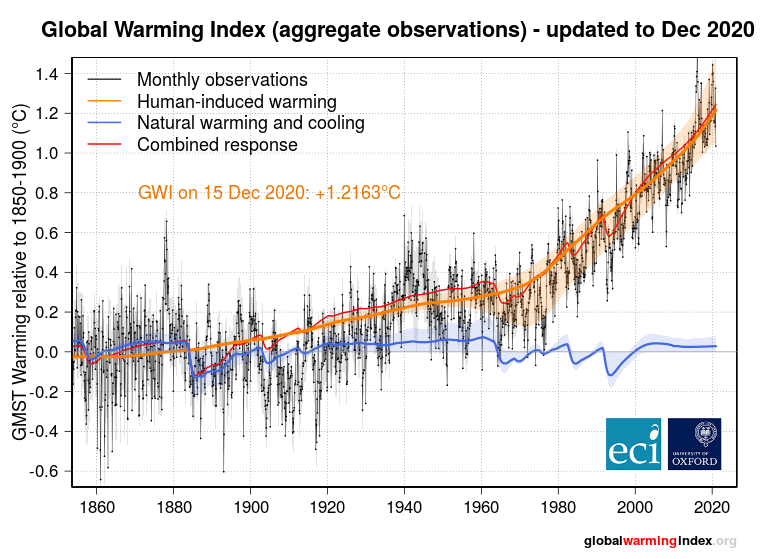Posted: Dec 18, 2017 9:59 am
If trend goes through 1.5C above pre-industrial around 2040, as would be expected from the GWI graph you posted two posts up, then given the various factors that cause global temperature to oscillate around the trendline, you'd expect to see 1.5C over pre-industrial earlier when one of those factors (such as IPO, or ENSO) is adding positive short-term variation to the trend. The trendline is already high enough that the last ENSO peak took us past 1.5C over pre-industrial for timeframes shorter than a year, for example.
Have a look at the chart you just posted, and tell me if 1.5C GWI by 2026 (out the top by the end of the x-axis) is consistent with current global temperature trends:

GWI has gone from 0.5C to 1.0C over the last 30 years. To project a similar rise to 1.5C in the next 9 years is a big call, and although the authors give a mechanism (IPO swing) they're also projecting that rise in 14 years without that mechanism, and the data don't seem to support a 0.5C trendline rise in temperature in such a short time. That's around twice the record decadal rise yet recorded for any decade. Sure, it's possible, but it's not a rate of warming that most climate scientists would subscribe to projecting over then next 9 years, but rather a figure right at the top of most projected ranges, or even a bit beyond the top.
Oh well, 9 years isn't that long to wait to see if you and Henley are right.
My personal view is that the Paris targets were set at 1.5C by 2100 exactly because that's unachievable, thus providing a political impetus for action when they're inevitably breached in another few decades. Outlier years like ENSO peaks going over 1.5C over pre-industrial even sooner will also (hopefully) concentrate a few relevant minds. We'll see, I guess.
Have a look at the chart you just posted, and tell me if 1.5C GWI by 2026 (out the top by the end of the x-axis) is consistent with current global temperature trends:

GWI has gone from 0.5C to 1.0C over the last 30 years. To project a similar rise to 1.5C in the next 9 years is a big call, and although the authors give a mechanism (IPO swing) they're also projecting that rise in 14 years without that mechanism, and the data don't seem to support a 0.5C trendline rise in temperature in such a short time. That's around twice the record decadal rise yet recorded for any decade. Sure, it's possible, but it's not a rate of warming that most climate scientists would subscribe to projecting over then next 9 years, but rather a figure right at the top of most projected ranges, or even a bit beyond the top.
Oh well, 9 years isn't that long to wait to see if you and Henley are right.
My personal view is that the Paris targets were set at 1.5C by 2100 exactly because that's unachievable, thus providing a political impetus for action when they're inevitably breached in another few decades. Outlier years like ENSO peaks going over 1.5C over pre-industrial even sooner will also (hopefully) concentrate a few relevant minds. We'll see, I guess.